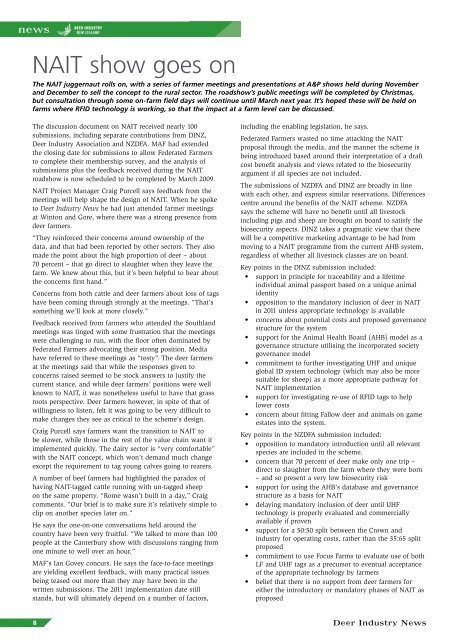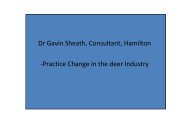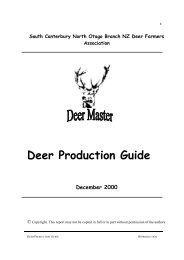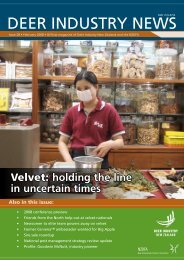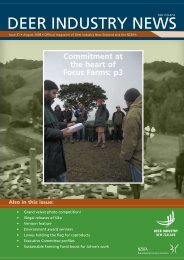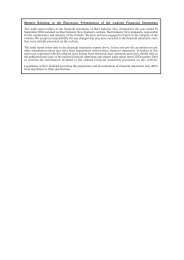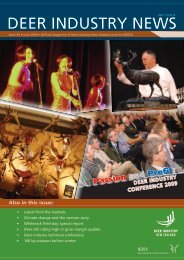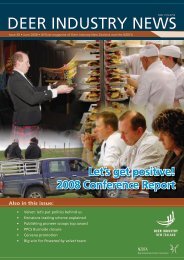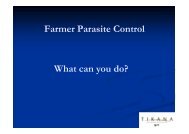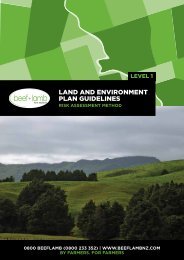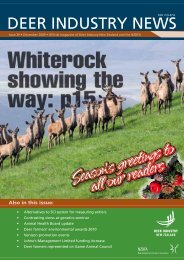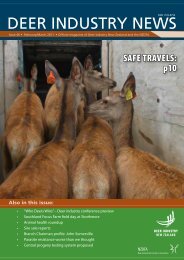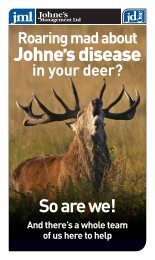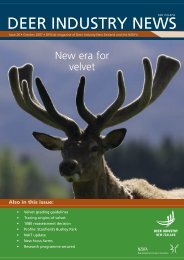Deer Industry News - Deer Industry New Zealand
Deer Industry News - Deer Industry New Zealand
Deer Industry News - Deer Industry New Zealand
Create successful ePaper yourself
Turn your PDF publications into a flip-book with our unique Google optimized e-Paper software.
news<br />
NAIT show goes on<br />
The NAIT juggernaut rolls on, with a series of farmer meetings and presentations at A&P shows held during November<br />
and December to sell the concept to the rural sector. The roadshow’s public meetings will be completed by Christmas,<br />
but consultation through some on-farm field days will continue until March next year. It’s hoped these will be held on<br />
farms where RFID technology is working, so that the impact at a farm level can be discussed.<br />
The discussion document on NAIT received nearly 100<br />
submissions, including separate contributions from DINZ,<br />
<strong>Deer</strong> <strong>Industry</strong> Association and NZDFA. MAF had extended<br />
the closing date for submissions to allow Federated Farmers<br />
to complete their membership survey, and the analysis of<br />
submissions plus the feedback received during the NAIT<br />
roadshow is now scheduled to be completed by March 2009.<br />
NAIT Project Manager Craig Purcell says feedback from the<br />
meetings will help shape the design of NAIT. When he spoke<br />
to <strong>Deer</strong> <strong>Industry</strong> <strong><strong>New</strong>s</strong> he had just attended farmer meetings<br />
at Winton and Gore, where there was a strong presence from<br />
deer farmers.<br />
“They reinforced their concerns around ownership of the<br />
data, and that had been reported by other sectors. They also<br />
made the point about the high proportion of deer – about<br />
70 percent – that go direct to slaughter when they leave the<br />
farm. We knew about this, but it’s been helpful to hear about<br />
the concerns first hand.”<br />
Concerns from both cattle and deer farmers about loss of tags<br />
have been coming through strongly at the meetings. “That’s<br />
something we’ll look at more closely.”<br />
Feedback received from farmers who attended the Southland<br />
meetings was tinged with some frustration that the meetings<br />
were challenging to run, with the floor often dominated by<br />
Federated Farmers advocating their strong position. Media<br />
have referred to these meetings as “testy”. The deer farmers<br />
at the meetings said that while the responses given to<br />
concerns raised seemed to be stock answers to justify the<br />
current stance, and while deer farmers’ positions were well<br />
known to NAIT, it was nonetheless useful to have that grass<br />
roots perspective. <strong>Deer</strong> farmers however, in spite of that of<br />
willingness to listen, felt it was going to be very difficult to<br />
make changes they see as critical to the scheme’s design.<br />
Craig Purcell says farmers want the transition to NAIT to<br />
be slower, while those in the rest of the value chain want it<br />
implemented quickly. The dairy sector is “very comfortable”<br />
with the NAIT concept, which won’t demand much change<br />
except the requirement to tag young calves going to rearers.<br />
A number of beef farmers had highlighted the paradox of<br />
having NAIT-tagged cattle running with un-tagged sheep<br />
on the same property. “Rome wasn’t built in a day,” Craig<br />
comments. “Our brief is to make sure it’s relatively simple to<br />
clip on another species later on.”<br />
He says the one-on-one conversations held around the<br />
country have been very fruitful. “We talked to more than 100<br />
people at the Canterbury show with discussions ranging from<br />
one minute to well over an hour.”<br />
MAF’s Ian Govey concurs. He says the face-to-face meetings<br />
are yielding excellent feedback, with many practical issues<br />
being teased out more than they may have been in the<br />
written submissions. The 2011 implementation date still<br />
stands, but will ultimately depend on a number of factors,<br />
including the enabling legislation, he says.<br />
Federated Farmers wasted no time attacking the NAIT<br />
proposal through the media, and the manner the scheme is<br />
being introduced based around their interpretation of a draft<br />
cost benefit analysis and views related to the biosecurity<br />
argument if all species are not included.<br />
The submissions of NZDFA and DINZ are broadly in line<br />
with each other, and express similar reservations. Differences<br />
centre around the benefits of the NAIT scheme. NZDFA<br />
says the scheme will have no benefit until all livestock<br />
including pigs and sheep are brought on board to satisfy the<br />
biosecurity aspects. DINZ takes a pragmatic view that there<br />
will be a competitive marketing advantage to be had from<br />
moving to a NAIT programme from the current AHB system,<br />
regardless of whether all livestock classes are on board.<br />
Key points in the DINZ submission included:<br />
• support in principle for traceability and a lifetime<br />
individual animal passport based on a unique animal<br />
identity<br />
• opposition to the mandatory inclusion of deer in NAIT<br />
in 2011 unless appropriate technology is available<br />
• concerns about potential costs and proposed governance<br />
structure for the system<br />
• support for the Animal Health Board (AHB) model as a<br />
governance structure utilising the incorporated society<br />
governance model<br />
• commitment to further investigating UHF and unique<br />
global ID system technology (which may also be more<br />
suitable for sheep) as a more appropriate pathway for<br />
NAIT implementation<br />
• support for investigating re-use of RFID tags to help<br />
lower costs<br />
• concern about fitting Fallow deer and animals on game<br />
estates into the system.<br />
Key points in the NZDFA submission included:<br />
• opposition to mandatory introduction until all relevant<br />
species are included in the scheme.<br />
• concern that 70 percent of deer make only one trip –<br />
direct to slaughter from the farm where they were born<br />
– and so present a very low biosecurity risk<br />
• support for using the AHB’s database and governance<br />
structure as a basis for NAIT<br />
• delaying mandatory inclusion of deer until UHF<br />
technology is properly evaluated and commercially<br />
available if proven<br />
• support for a 50:50 split between the Crown and<br />
industry for operating costs, rather than the 35:65 split<br />
proposed<br />
• commitment to use Focus Farms to evaluate use of both<br />
LF and UHF tags as a precursor to eventual acceptance<br />
of the appropriate technology by farmers<br />
• belief that there is no support from deer farmers for<br />
either the introductory or mandatory phases of NAIT as<br />
proposed<br />
8<br />
<strong>Deer</strong> <strong>Industry</strong> <strong><strong>New</strong>s</strong>


